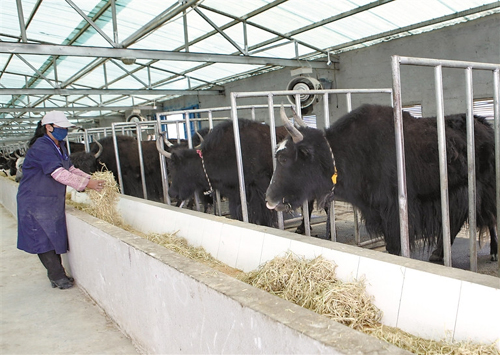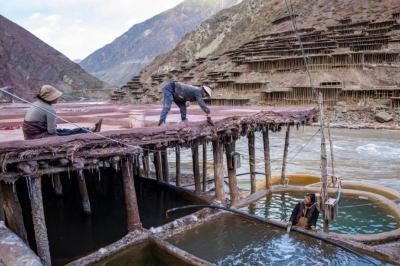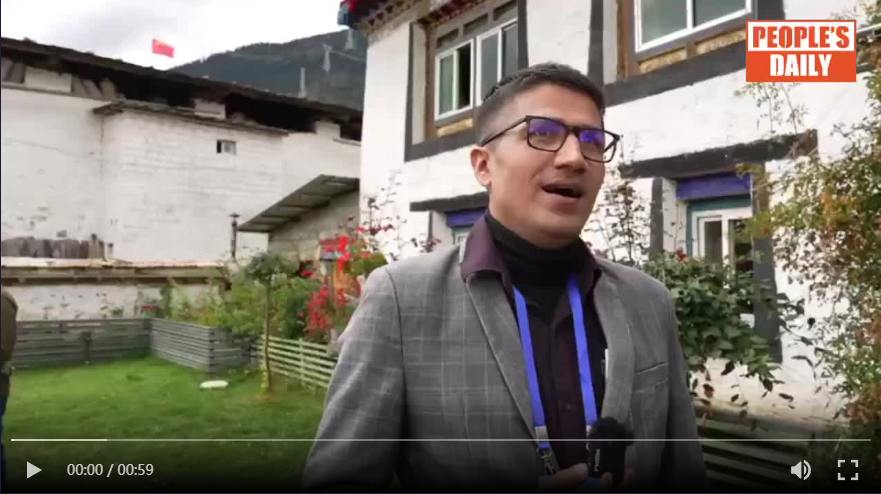 Nov.15,2019 -- Photo shows workers feeding yaks at the demonstration base of animal husbandry industry in Nagqu City, southwest China's Tibet Autonomous Region. [China Tibet News/Lozang, Tsewang] Nov.15,2019 -- In recent years, Tibet's yak industry plays an important role in increasing the income of farmers and herdsmen. With an increase of investment as well as the promotion of fine breeds and good cultivation, the yak industry has seen a steady increase of breeding stock and slaughter rate.
Among the 17 yak breeds certified by the national commission for genetic resources of livestock and poultry, there are four in Tibet, breeding Pagri yak, Riwoqe yak and others.
In 2018, the number of yaks breeding stock reached 4.81 million, up 12.1% compared with that of year 2011, and its commodity rate of beef reached 26.42%.
Tibet is rich in yak resources. In its vast pastoral area, the income growth brought by yaks indicates the rapid development of yak industry on plateau.
In June of 2019, a symposium on the development of poverty alleviation through highland barley and yak, and the economic construction of river valley was held in Lhasa, capital of southwest China's Tibet Autonomous Region. With an investment of 120 million yuan RMB in the economic development along the Yarlung Zangbo River basin and its tributary valleys, the yak industry will achieve greater improvement. In 2020, the number of yak breeding stock is expected to hit over five million.
Tibet boasts a vast area of grassland. The output value of animal husbandry accounts for more than 50% of the regional agriculture and animal husbandry's total. The development of animal husbandry is closely related to the living and production of farmers and herdsmen. However, the traditional production way limits its development. In recent years, the region has focused on its development schedule and issued a series of policies to upgrade the animal and husbandry industry, providing a broad development prospect for husbandry economy.
"After short-term fattening, each yak gains an average weight of 37 kg. The net income increases by more than 2,000 yuan RMB," says Quga, who owns a pasture in Duiling Village of Nyingdrong Town of Damxung County in Lhasa. "The county's Pureland Company office will purchase these yaks, which solves the problems of sales difficulty.”
Short-term fattening of yaks is a specific measure of industry transformation and upgrading. In 2018, the number of yaks being fattened in short term stood at 48,531, and the sales of yak meat amounted to 6,673 tons, which brought a net income of 91.33 million yuan RMB, realizing 827 yuan RMB per capita income increase,and benefiting 110,416 people from 26,858 households.
This yea, short-term fattening of yaks has been carried out in six cities of Tibet. After the fattening, the number of yak breeding stock is expected to be 70,000.
The region has also pushed forward constructing fine breeds of livestock and worked harder to advance the development of yak industry. Last year, Tibet gained an investment of 10 million yuan RMB from state fund, and launched the integration project of Riwoqe yak. According to relevant data, the rate of fine breed is about 17.6%.
In agricultural areas, semi-agricultural and semi-pastoral areas, the region has made efforts to speed up the construction of artificial forging bases. In 2018, with an investment of 2.19 billion yuan RMB, an area of 3.35 million mu (2,238.66km2) was planted with grasses. Now, the regional reserve area of artificial forging bases is 1.57 million mu (1046.66km2).
Tibet has promoted the exhibition economy and built a connection between production and sales. The Tibet Expo and Trade Fairs greatly broaden the sales channels of livestock products and accelerate the balanced development of sales and production. Cultivation of local leading companies extends the industrial chains of yak industry.
Products made of yak boast original ecology, green, good taste and quality.
Now, there are seven yak meat processing companies. The annual processing quantity is 2,165 tons.
"I never thought that I could work in a company and have a fixed annual salary," says 49-year-old Phuntsog Tsering, a villager of Khorchen Village in Lungring Town of Lhasa's Damxung County, who has made a living by herding livestock in the past. "Because of yaks, our life becomes better," Phuntsog Tsering says with smile.
|
- Home
- News Tibet |Exclusive |China |World |Related News |Latest
- Documents White Papers |Others
- Photo Politics |Economy & Society |Culture & Religion |Human & Nature |Beautiful Tibet |Other Tibetan-Inhabited Area |Exchanges |Related
- Video News |Documentary |Micro-Video |Entertainment
- Art
- Tourism
- In Focus
- About Tibet






